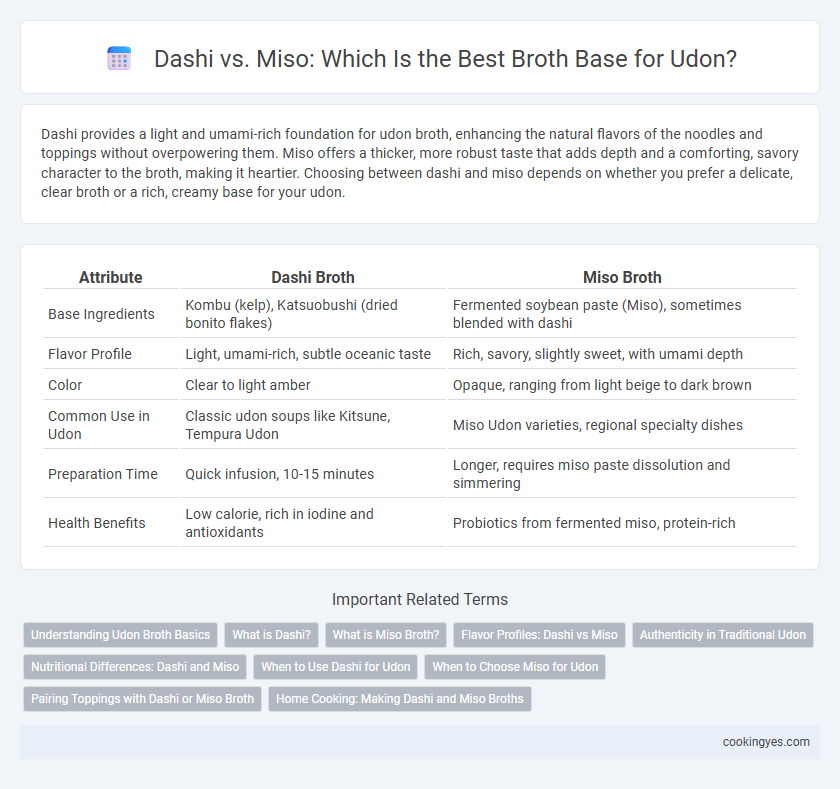Dashi provides a light and umami-rich foundation for udon broth, enhancing the natural flavors of the noodles and toppings without overpowering them. Miso offers a thicker, more robust taste that adds depth and a comforting, savory character to the broth, making it heartier. Choosing between dashi and miso depends on whether you prefer a delicate, clear broth or a rich, creamy base for your udon.
Table of Comparison
| Attribute | Dashi Broth | Miso Broth |
|---|---|---|
| Base Ingredients | Kombu (kelp), Katsuobushi (dried bonito flakes) | Fermented soybean paste (Miso), sometimes blended with dashi |
| Flavor Profile | Light, umami-rich, subtle oceanic taste | Rich, savory, slightly sweet, with umami depth |
| Color | Clear to light amber | Opaque, ranging from light beige to dark brown |
| Common Use in Udon | Classic udon soups like Kitsune, Tempura Udon | Miso Udon varieties, regional specialty dishes |
| Preparation Time | Quick infusion, 10-15 minutes | Longer, requires miso paste dissolution and simmering |
| Health Benefits | Low calorie, rich in iodine and antioxidants | Probiotics from fermented miso, protein-rich |
Understanding Udon Broth Basics
Dashi, a Japanese stock made from kombu seaweed and bonito flakes, serves as the fundamental umami-rich base for udon broth, providing a delicate and savory flavor. Miso, a fermented soybean paste, adds a deeper, more robust taste and creamy texture when used as a broth base, often mixed with dashi to balance richness and umami. Understanding these broth elements is essential for mastering udon's flavor profile, as dashi emphasizes clarity and lightness while miso introduces heartiness and complexity.
What is Dashi?
Dashi is a traditional Japanese broth fundamental to udon, made by simmering ingredients such as kombu (kelp) and katsuobushi (dried bonito flakes) to extract a rich umami flavor. It serves as the essential base for many Japanese soups and sauces, providing a delicate, savory depth that enhances udon's taste. Unlike miso, which is a fermented soybean paste added later, dashi forms the clear, flavorful liquid foundation crucial for authentic udon broth.
What is Miso Broth?
Miso broth for udon is a savory, fermented soybean paste-based soup that delivers rich umami flavor and a creamy texture. This broth contrasts with dashi, which is traditionally made from kombu (kelp) and katsuobushi (bonito flakes), offering a lighter, clearer taste. The robust, slightly tangy profile of miso broth enhances udon noodles, providing a heartier and more nutrient-dense option.
Flavor Profiles: Dashi vs Miso
Dashi broth for udon offers a delicate umami flavor derived from kombu seaweed and bonito flakes, creating a light, savory base that enhances the noodles without overpowering them. Miso broth provides a richer, more robust taste profile, featuring fermented soybean paste that adds depth, saltiness, and a slightly sweet, tangy complexity to the udon soup. While dashi highlights subtle oceanic and smoky notes, miso delivers a creamier, heartier experience, making each broth distinct in traditional Japanese cuisine.
Authenticity in Traditional Udon
Traditional udon broth base relies heavily on dashi, crafted from kombu seaweed and katsuobushi flakes, delivering a delicate umami flavor essential to authentic Japanese cuisine. While miso adds a rich, hearty taste often used in miso soup, it alters the light and subtle profile characteristic of classic udon dishes. Authentic udon emphasizes clear, balanced dashi broth to preserve the cultural integrity and traditional flavor experience of Japan's beloved noodle soup.
Nutritional Differences: Dashi and Miso
Dashi, a clear broth made from kombu seaweed and bonito flakes, is low in calories and rich in minerals like iodine and potassium, supporting thyroid and cardiovascular health. Miso, a fermented soybean paste, offers higher protein content, beneficial probiotics for gut health, and essential vitamins such as B12 and K. Combining dashi and miso in udon broth enhances the nutritional profile by providing a balance of amino acids, antioxidants, and digestive enzymes.
When to Use Dashi for Udon
Dashi is ideal for udon when a light, umami-rich broth is desired, enhancing the noodle's subtle flavor without overpowering it. It pairs best with simple toppings like scallions, tempura, or fish cakes, allowing the clean, savory notes of kombu and bonito flakes to shine. Use dashi-based broth for traditional Japanese udon dishes such as kake udon or kitsune udon, emphasizing authentic, delicate taste profiles.
When to Choose Miso for Udon
Choose miso for udon broth when a rich, umami-packed flavor is desired, as its fermented soybean base adds depth and a slightly creamy texture. Miso varieties like white (shiro) or red (aka) miso can tailor the broth's intensity, making it ideal for heartier udon dishes featuring robust toppings such as pork, mushrooms, or tofu. This choice enhances warmth and complexity, perfect for colder seasons or when aiming for a comforting, savory experience.
Pairing Toppings with Dashi or Miso Broth
Dashi broth's light, umami-rich flavor pairs exceptionally well with delicate toppings like tempura, green onions, and kamaboko, enhancing the subtle seafood notes without overpowering them. Miso broth offers a robust, savory base that complements heartier toppings such as tofu, mushrooms, spinach, and pork, creating a rich, comforting bowl of udon. Selecting the broth based on these complementary toppings ensures a balanced and flavorful udon experience.
Home Cooking: Making Dashi and Miso Broths
Dashi, a traditional Japanese broth made from kombu (kelp) and katsuobushi (bonito flakes), is essential for creating a subtle umami flavor base in udon dishes, while miso broth introduces a rich, fermented soybean taste that enhances depth and warmth. Home cooks typically prepare dashi by simmering kombu and katsuobushi in water for about 20 minutes, straining out solids to achieve a clear, savory stock. For miso broth, dashi serves as the base, with miso paste dissolved in hot broth just before serving to preserve probiotics and maintain a balanced, creamy texture ideal for udon.
Dashi vs Miso for udon broth base Infographic

 cookingyes.com
cookingyes.com